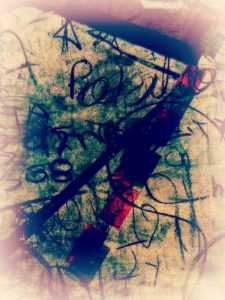An letter by Lisa Mullins, PhD, as provided by Julia K. Patt
Art by Dawn Vogel
Greetings Fellow Plodder in the Academic Trenches,
If you’ve received this binder, it means you have had the misfortune of being assigned BIO 457 as your T.A. post for the semester. My sincere condolences.
I was once like you–beleaguered and overwhelmed, fretting about comps and unresponsive advisors and publications and postdoc appointments. Trust me when I say that to survive T.A.-ing this class, you have to put those concerns from your mind. Study, yes. Fulfill your responsibilities as well as you can. But don’t lose your focus in 457, or you’ll be facing a lot worse than asking for a dissertation extension or disappointing your committee members.
First things first: Unless he’s died or wandered off, Dr. Piotrowski always teaches this class. He is roughly 900 years old, can’t see further than three feet in front of his nose, and sounds like a leaking radiator when he lectures. But don’t underestimate him. I once saw him push a junior biochemistry lab assistant through a portal to another dimension just to see what would happen. Never get between Dr. P and a portal.
Over the years, his experiments have included ice rays, death rays, hypnotic rays, sleep rays, kill-chip implanted super soldiers, undead kill-chip implanted super soldiers, shark-cyborg hybrids, undead shark-cyborg hybrids, contacting chthonic deities, talking apes, extrasensory perception serums, piercing the veil, and a twenty-foot mecha one of our predecessors called the Salad Spinner of Death.
And that’s just in the spring semesters.
More undergraduates go missing in 457 than during study abroad trips to countries flagged by the CIA.
Depending on your level of cynicism and how many intro classes you’ve T.A.-ed for previously, you may be tempted to try to save the students. Don’t bother. I’m not saying undergraduates are expendable. I am saying that in many cases, it will be you or them, and if they’re still drunk from the night before, they might not even feel anything.

If you’ve received this binder, it means you have had the misfortune of being assigned BIO 457 as your T.A. post for the semester. My sincere condolences.
To read the rest of this story, check out the Mad Scientist Journal: Summer 2018 collection.
Lisa Mullins, PhD, is the founder of the Society for Responsibility in the Mad Sciences. Currently a postdoc at [redacted] University, her academic interests include gene therapy, immunology, and preventing the rise of sentient artificial constructs which will subjugate all mankind. She has never sacrificed an undergraduate to a portal of unspeakable evil. Probably.
Julia K. Patt lives in Maryland with the smallest, furriest Elder God and her unwitting orange tabby acolyte, which never fails to make life interesting. Her stories have recently appeared in Clarkesworld, Escape Pod, and Luna Station Quarterly, and she is at work on a novel. Twitter: @chidorme. Website: juliakpatt.com
Dawn Vogel writes and edits both fiction and non-fiction. Although art is not her strongest suit, she’s happy to contribute occasional art to Mad Scientist Journal. By day, she edits reports for and manages an office of historians and archaeologists. In her alleged spare time, she runs a craft business and tries to find time for writing. She lives in Seattle with her awesome husband (and fellow author), Jeremy Zimmerman, and their herd of cats. For more of Dawn’s work, visit http://historythatneverwas.com/.
“T.A. Guide for BIO 457: Advanced Experimental Models” is © 2018 Julia K. Patt
Art accompanying story is © 2018 Dawn Vogel
